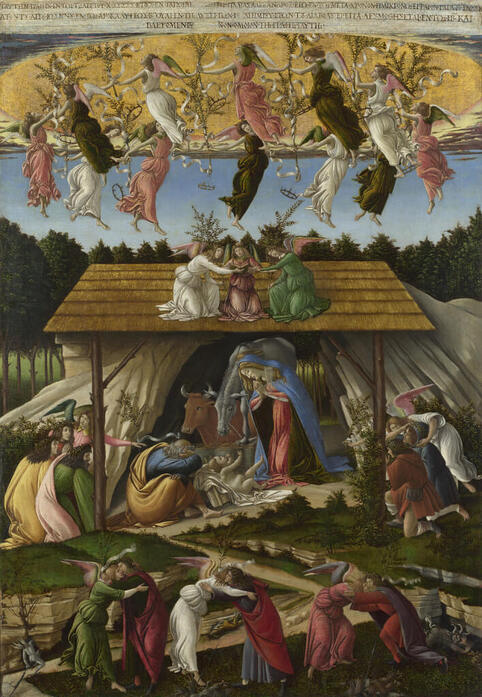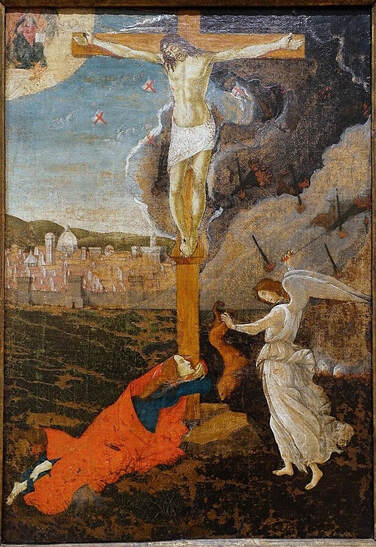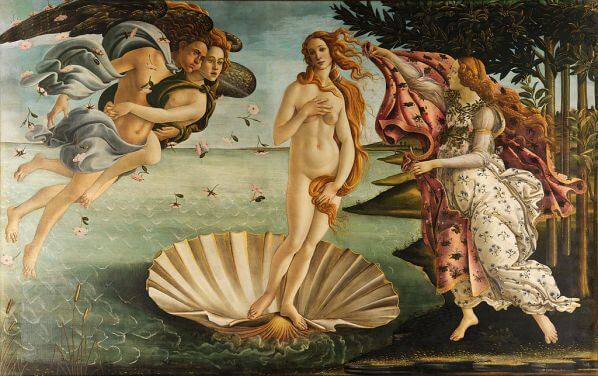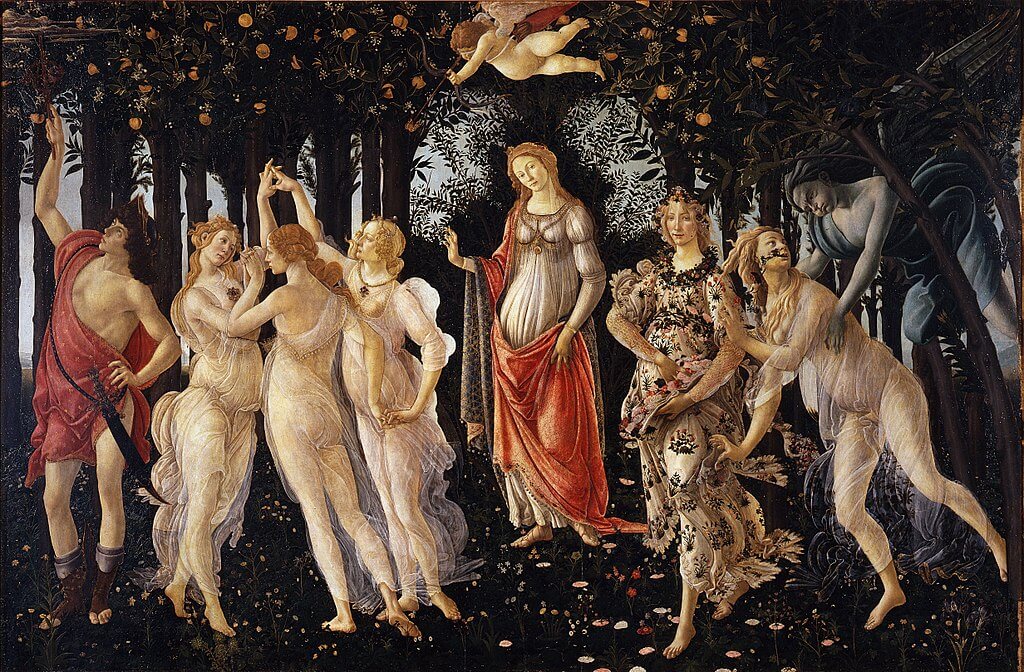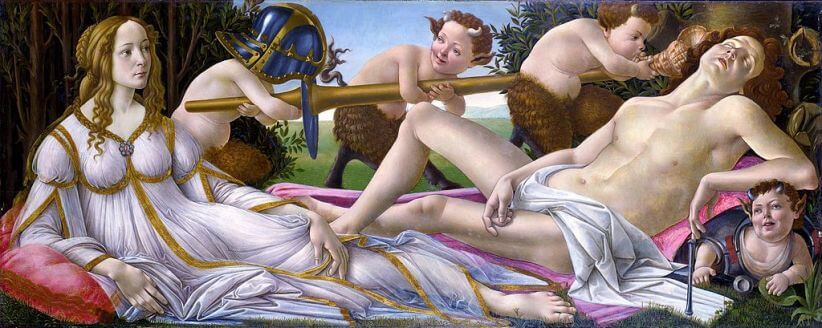|
Where? Room 57 of the National Gallery
When? 1500 Commissioned by? Botticelli probably made this picture for himself What do you see? In the center of this painting, you can see a naked baby Jesus. His mother, the Virgin Mary, is depicted to his right and is much larger than the other figures. His father, Saint Joseph, is on his left. Behind Jesus are a horse and an ox. Together they are staying in a stable. On top of the stable are three angels. One is reading a book, and the other two are holding an olive branch. To the left of Joseph is an angel in pink, holding an olive branch with a scroll attached to it, while reaching out to Joseph to introduce the three wise men. On the right of Mary is another angel with three shepherds who want to pay their respects to Jesus. In the foreground are three pairs consisting of one angel and one man embracing each other. Each pair holds an olive branch in their hand with a scroll attached to it. They are surrounded by several little imps or devils who are killing themselves with their spears. On top of the painting is a choir of 12 angels holding hands. The angels are doing a mystic ring dance. They are also holding an olive branch in their hands with a scroll attached to it and a crown hanging at the bottom of the branch. The angels are under the golden dome of heaven. Above this dome is a Greek inscription based on some parts of the Revelations of John related to the apocalypse. Backstory: This painting is also called ‘The Mystical Nativity’, and it is the only painting that Botticelli signed. This painting combines the story of the birth of Jesus with his return to earth according to the apocalypse. The title of this painting contains the word mystic because the parts of the painting referring to the apocalypse are prophetic and express a mystery. The word mystic is occasionally used to refer to exceptional paintings with mysterious and symbolic content. Another example of such a painting is the Mystic Crucifixion by Botticelli which is in the Fogg Art Museum in Boston.
Inscription: The inscription on top of the painting contains a message in Greek. It is translated as: “I Sandro painted this picture at the end of the year 1500 in the troubles in Italy in the half time after the time according to the 11th chapter of St. John in the second woe of the Apocalypse in the loosing of the devil for three and a half years. Then he will be chained in the 12th chapter and we shall see him trodden down as in this picture.” This message of Botticelli is based on the 11th and 12th chapter of the Revelations of John.
Botticelli believed that the apocalypse as described in the Bible was going to happen in 1504. Specifically, he believed that he was living in the Tribulation, a short period of time in which the world would suffer from hardship and disasters. He believed that the Millennium, a period of a thousand years during which Jesus would return to earth, would start in three and a half years. This belief of Botticelli was particularly based on the various wars going on at that time and the hanging, two years earlier, of the Florentine preacher Savonarola of whom Botticelli was a follower. Symbolism:
Who is Botticelli? Sandro Botticelli (1445-1510) was born as Alessandro di Mariano di Vanni Filipepi in Florence. Most of his paintings have a religious theme, but he also painted portraits and mythological scenes. The latter theme resulted in his most famous works, such as The Birth of Venus and La Primavera, both in the Uffizi Museum. His painting of Venus and Mars, which is also in the National Gallery, is also a masterpiece. In the 1490s, Botticelli got heavily influenced by the extremist preacher Savonarola, and he even stopped painting for a while to become a full member of Savonarola’s sect. However, he picked up painting again after a while, though his productivity was lower than before (though this is not entirely certain as almost all paintings of Botticelli are undated).
Fun fact: The Nativity scene in this painting is the story of the birth of Jesus as described in the gospels of Matthew and Luke. Mary was still a virgin, and God promised her that she would give birth to the Christ. The accounts of Matthew and Luke, however, differ quite a bit and both have their unique components.
According to Matthew, Jesus was visited by three wise men who followed a star to worship him. Luke describes that an angel announces the birth of Jesus to the shepherds and that they subsequently visit Jesus. Also, according to Luke, but not according to Matthew, the birth of Jesus happened in Bethlehem and Jesus was born in a stable. Botticelli combined elements from both gospels for this painting. Interested in a copy for yourself? Poster of canvas.
Written by Eelco Kappe
References:
0 Comments
Leave a Reply. |
Categories
All
|
- Home
- Blog
-
Museums
- Alte Pinakothek
- Art Institute of Chicago
- Baltimore Museum of Art
- Barber Institute of Fine Arts
- Bargello
- Barnes Foundation
- British Museum
- Church of Sant’Anastasia
- Cleveland Museum of Art
- Courtauld Institute of Art
- Detroit Institute of Arts
- Frans Hals Museum
- Galleria Borghese
- Gallerie dell'Accademia
- Getty Museum
- Guggenheim
- Hermitage Museum
- Kunsthistorisches Museum
- Kunstmuseum Basel
- Legion of Honor Museum
- Louvre
- Mauritshuis
- Metropolitan Museum of Art
- Musee d’Orsay
- Museum of Fine Arts in Boston
- Museum of Modern Art
- National Gallery in London
- National Gallery of Art
- National Museum in Poznań
- Norton Simon Museum
- Ny Carlsberg Glyptotek
- Palace of Versailles
- Palazzo Pitti
- Palazzo Vecchio
- Petit Palais
- Philadelphia Museum of Art
- Prado
- Pushkin Museum
- Ravenna Art Museum
- Rijksmuseum
- San Diego Museum of Art
- Santa Maria delle Grazie
- St. Peter's Basilica
- Städel Museum
- Statens Museum for Kunst
- Tate Britain
- Tate Modern
- Timken Museum of Art
- Uffizi
- Vatican Museums
- Wallace Collection
-
Artists
- Altdorfer
- Anguissola
- Berlin Painter
- Bosch
- Botticelli
- Boucher
- Bronzino
- Bruegel the Elder
- Brunelleschi
- Cabanel
- Caillebotte
- Canova
- Caravaggio
- Carpeaux
- Cezanne
- Cimabue
- David
- Degas
- Delacroix
- De Maria
- Donatello
- El Greco
- Fontana
- Fra Angelico
- Fragonard
- Gauguin
- Gentileschi
- Gericault
- Gonzalez-Torres
- Goya
- Hals
- Hogarth
- Hokusai
- Ingres
- Leonardo da Vinci
- Lippi, Filippo
- Longhi, Barbara
- Lorrain
- Makovsky
- Manet
- Massys
- Matisse
- Merian
- Michelangelo
- Mochi
- Modigliani
- Monet
- Panini
- Parmigianino
- Perugino
- Picasso
- Pisanello
- Raphael
- Rembrandt
- Renoir
- Reynolds
- Rivera
- Rodin
- Rubens
- Scultori
- Seurat
- Steen
- Tintoretto
- Titian
- Toulouse-Lautrec
- Turner
- Uccello
- Van der Weyden
- Van Dyck
- Van Eyck
- Van Gogh
- Van Hemessen
- Vasari
- Velazquez
- Vermeer
- Veronese
- Vigée Le Brun
-
Locations
- Books
- About Us

